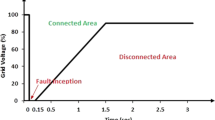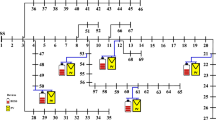Abstract
In this paper, a solution is provided for solving optimal reactive power dispatch (ORPD) problem by using flexible alternating current transmission (FACTS) devices. The TLBO method is applied on IEEE 14-, 30- and 57- bus test system with optimal positioning of thyristor-controlled series compensator (TCSC) and static var compensator (SVC). The location for TCSC and SVC has been chosen by performing power flow analysis. The ORPD problem is formulated to minimize both active power loss and operating cost. The main objective of this work is to dispatch optimal reactive power considering various loading conditions. The performance of the proposed method is tested under increased reactive loading and simultaneous increased of both active and reactive loading conditions. The proposed method's performance is evaluated under various operating conditions. The obtained results are compared with some of the recent promising techniques such as KHA, BBO and PSO. The simulation results show the efficacy of the proposed method in achieving the better performance of the system in terms of minimum power loss, minimum operating cost and better convergence rate.
















Similar content being viewed by others
References
Aghaei J, Gitizadeh M, Kaji M (2012) Placement and operation strategy of FACTS devices using optimal continuous power flow. Sci Iranica 19(6):1683–1690
Babu R, Raj S, Bhattacharyya B (2020) Weak bus-constrained PMU placement for complete observability of a connected power network considering voltage stability indices. Prot Control Modern Power Syst 5(1):1–14
Babu R, Raj S, Dey B, Bhattacharyya B (2021) Modified branch‐and‐bound algorithm for unravelling optimal PMU placement problem for power grid observability: a comparative analysis. CAAI Trans Intell Technol 6(4):450–470. https://doi.org/10.1049/cit2.12038
Babu R, Gupta VK, Subbaramaiah K (2021) An approach to unravel the optimal PMU placement problem for full observability of power network in view of contingencies. Int J Syst Assur Eng Manag 13(3):1170–1186. https://doi.org/10.1007/s13198-021-01412-4
Bhattacharya A, Chattopadhyay PK (2011) Application of biogeography-based optimisation to solve different optimal power flow problems. IET Gener Transm Distrib 5(1):70–80
Bhattacharyya B, Kumar S (2015) Reactive power planning with FACTS devices using gravitational search algorithm. Ain Shams Eng J 6(3):865–871
Bhattacharyya B, Kumar S (2016) Loadability enhancement with FACTS devices using gravitational search algorithm. Int J Electr Power Energy Syst 1(78):470–479
Bhattacharyya B, Kumar S (2016) Approach for the solution of transmission congestion with multi-type FACTS devices. IET Gener Transm Distrib 10(11):2802–2809
Biswas PP, Arora P, Mallipeddi R, Suganthan PN, Panigrahi BK (2021) Optimal placement and sizing of FACTS devices for optimal power flow in a wind power integrated electrical network. Neural Comput Appl 33(12):6753–6774
Dash SP, Subhashini KR, Satapathy JK (2020) Optimal location and parametric settings of FACTS devices based on JAYA blended moth flame optimization for transmission loss minimization in power systems. Microsyst Technol 26(5):1543–1552
Duman S, Güvenç U, Sönmez Y, Yörükeren N (2012) Optimal power flow using gravitational search algorithm. Energy Convers Manage 1(59):86–95
El-Araby ES, Yorino N (2018) Reactive power reserve management tool for voltage stability enhancement. IET Gener Transm Distrib 12(8):1879–1888
Esmaili M, Shayanfar HA, Moslemi R (2014) Locating series FACTS devices for multi-objective congestion management improving voltage and transient stability. Eur J Oper Res 236(2):763–773
Gerbex S, Cherkaoui R, Germond AJ (2001) Optimal location of multi-type FACTS devices in a power system by means of genetic algorithms. IEEE Trans Power Syst 16(3):537–544
Hassan LH, Moghavvemi M, Almurib HA, Steinmayer O (2013) Application of genetic algorithm in optimization of unified power flow controller parameters and its location in the power system network. Int J Electr Power Energy Syst 1(46):89–97
Jordehi AR (2015) Brainstorm optimisation algorithm (BSOA): an efficient algorithm for finding optimal location and setting of FACTS devices in electric power systems. Int J Electr Power Energy Syst 1(69):48–57
Kar MK, Kumar S, Singh AK, Panigrahi S (2021) Reactive power management by using a modified differential evolution algorithm. Optim Control Appl Methods. https://doi.org/10.1002/oca.2815
Kar MK, Kumar L, Kumar S, Singh AK (2020) Efficient operation of power system with FACTS controllers using evolutionary techniques. In: 2020 7th international conference on signal processing and integrated networks (SPIN) IEEE. pp 962–965
Kumar L, Kar MK, Kumar S (2021) Reactive power management by optimal positioning of FACTS controllers using MFO algorithm. In: 2021 Emerging trends in industry 4.0 (ETI 4.0) IEEE. pp 1–6
Mohanty B, Tripathy S (2016) A teaching learning based optimization technique for optimal location and size of DG in distribution network. J Electrical Syst Inf Technol 3(1):33–44. https://doi.org/10.1016/j.jesit.2015.11.007
Mukherjee A, Mukherjee V (2015) Solution of optimal reactive power dispatch by chaotic krill herd algorithm. IET Gener Transm Distrib 9(15):2351–2362
Nagalakshmi S, Kamaraj N (2012) Comparison of computational intelligence algorithms for loadability enhancement of restructured power system with FACTS devices. Swarm Evol Comput 1(5):17–27
Nusair K, Alasali F, Hayajneh A, Holderbaum W (2021) Optimal placement of facts devices and power‐flow solutions for a power network system integrated with stochastic renewable energy resources using new metaheuristic optimization techniques. Int J Energy Res 45(13):18786–18809. https://doi.org/10.1002/er.6997
Rao RV, Savsani VJ, Vakharia DP (2012) Teaching–learning-based optimization: an optimization method for continuous non-linear large scale problems. Inf Sci 183(1):1–5
Roselyn JP, Devaraj D, Dash SS (2018) Voltage-based reactive power pricing in deregulated environment using hybrid multi-objective particle swarm optimisation. Int J Ambient Energy 39(3):285–296
Sarker J, Goswami SK (2014) Solution of multiple UPFC placement problems using gravitational search algorithm. Int J Electr Power Energy Syst 1(55):531–541
Shehata AA, Refaat A, Ahmed MK, Korovkin NV (2021) Optimal placement and sizing of FACTS devices based on autonomous groups particle swarm optimization technique. Arch Electrical Eng. https://doi.org/10.24425/aee.2021.136059
Singh SP (2016) Congestion mitigation using UPFC. IET Gener Transm Distrib 10(10):2433–2442
Taher MA, Kamel S, Jurado F, Ebeed M (2020) Optimal power flow solution incorporating a simplified UPFC model using lightning attachment procedure optimization. Int Trans Electrical Energy Syst 30(1):e12170
Wibowo RS, Yorino N, Eghbal M, Zoka Y, Sasaki Y (2011) FACTS devices allocation with control coordination considering congestion relief and voltage stability. IEEE Trans Power Syst 26(4):2302–2310
Yousefi A, Nguyen TT, Zareipour H, Malik OP (2012) Congestion management using demand response and FACTS devices. Int J Electr Power Energy Syst 37(1):78–85
Author information
Authors and Affiliations
Corresponding author
Ethics declarations
Conflict of interest
Authors doesn’t have any conflict of interest.
Human or animal rights
Research involving Human Participants and/or Animals: Human Participants and/or Animals are not involved in this research.
Informed consent
There was no informed consent in this research article.
Additional information
Publisher's Note
Springer Nature remains neutral with regard to jurisdictional claims in published maps and institutional affiliations.
Rights and permissions
About this article
Cite this article
Gupta, S.K., Kumar, L., Kar, M.K. et al. Optimal reactive power dispatch under coordinated active and reactive load variations using FACTS devices. Int J Syst Assur Eng Manag 13, 2672–2682 (2022). https://doi.org/10.1007/s13198-022-01736-9
Received:
Revised:
Accepted:
Published:
Issue Date:
DOI: https://doi.org/10.1007/s13198-022-01736-9




